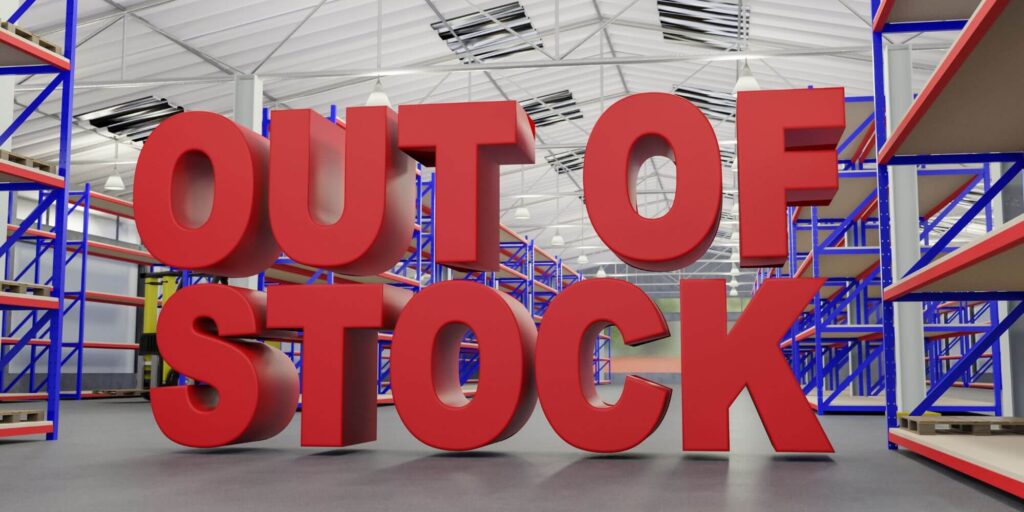In the fast-paced realm of e-commerce, the balancing act of inventory management is crucial. While overstocking can tie up valuable resources, understocking poses its own set of challenges that can significantly impact an e-commerce business’s success. In this comprehensive article, we delve into the world of “understocking” – the risks it presents, the factors contributing to its occurrence, and the strategic measures e-commerce businesses can adopt to effectively mitigate its detrimental effects.
What is Understocking?
Understocking refers to a situation in which a business maintains insufficient inventory levels to meet customer demand. This results in shortages of products, leading to unfulfilled orders, lost sales opportunities, customer dissatisfaction, and operational disruptions. Understocking can occur due to inaccurate demand forecasting, supply chain disruptions, seasonal fluctuations, or unforeseen market shifts. E-commerce businesses must address understocking challenges strategically to maintain customer satisfaction, maximize revenue, and ensure efficient operations.
The Impact of Understocking on eCommerce Businesses
Understocking can have significant and far-reaching impacts on businesses, especially in the context of e-commerce. Here are some ways understocking affects businesses:
- Lost Revenue and Sales Opportunities: When products are out of stock, potential customers are unable to make purchases. This directly translates to lost sales and revenue. Customers who can’t find the products they want might turn to competitors, leading to missed opportunities for growth.
- Customer Dissatisfaction: Unfulfilled orders and unavailable products frustrate customers and damage their perception of the business’s reliability. This dissatisfaction can result in negative reviews, decreased customer loyalty, and even long-term brand abandonment.
- Operational Inefficiencies: Understocking forces businesses into a reactive mode. Rushing to replenish inventory on short notice disrupts normal operational workflows. This can lead to higher costs for expedited shipping, increased workload for staff, and strained supply chain relationships.
- Increased Fulfillment Costs: Urgent restocking efforts might involve expedited shipping or sourcing products at higher costs, eroding profit margins. Additionally, last-minute adjustments disrupt warehouse and distribution center operations, leading to inefficiencies.
- Missed Growth Opportunities: Businesses unable to meet demand miss out on potential growth. E-commerce businesses, in particular, might struggle to scale up and expand their customer base due to inadequate stock levels.
- Brand Reputation Impact: Understocking can tarnish a business’s reputation. Negative experiences shared by dissatisfied customers can spread quickly through social media and online reviews, potentially deterring new customers from making purchases.
- Lack of Customer Confidence: Repeated instances of understocking can erode customer trust in the business’s ability to provide reliable service. This lack of confidence can lead to decreased repeat purchases and customer retention.
- Unpredictable Demand Shocks: Unexpected spikes in demand, whether due to marketing efforts, viral trends, or external events, can catch businesses off guard. Understocking during these times not only results in missed sales but also leaves businesses ill-equipped to capitalize on opportunities.
- Difficulty in Forecasting Accuracy: Understocking challenges can stem from inaccurate demand forecasting. This can make it difficult for businesses to accurately predict future trends and respond effectively to changing market dynamics.
What Are The Factors Contributing to Understocking?
Understocking can arise from various factors that disrupt the balance between supply and demand. These factors can vary across industries and business contexts. Here are some common causes of understocking:
- Inaccurate Demand Forecasting: Relying on outdated or flawed demand forecasting methods can result in understocking. Inaccurate predictions fail to capture shifts in consumer preferences, seasonal trends, or unexpected demand spikes.
- Seasonal Fluctuations: E-commerce businesses often experience seasonal variations in demand, such as during holidays or special occasions. Failing to anticipate and prepare for these fluctuations can lead to inventory shortages.
- Supplier Delays and Shortages: Disruptions in the supply chain, whether due to delayed shipments, production issues, or shortages of raw materials, can lead to insufficient inventory levels.
- Rapid Market Changes: the e-commerce landscape is influenced by rapidly changing consumer behavior, emerging trends, and market shifts. Failure to quickly adapt to these changes can result in understocking.
- Unforeseen Events: Unexpected events, such as sudden spikes in demand due to viral trends or unforeseen external factors (e.g., global pandemics), can catch businesses off guard and lead to shortages.
- Demand Variability: Products with unpredictable demand patterns can be prone to understocking. These might include niche or trending items that experience sudden surges in popularity.
- Economic Factors: Economic fluctuations, such as changes in disposable income or consumer spending patterns, can impact demand levels and lead to understocking if not accounted for.
- Lack of Safety Stock: Safety stock serves as a buffer to address demand variability or supply disruptions. Insufficient safety stock can leave businesses vulnerable to understocking during unexpected fluctuations.
- Inventory Management Practices: Poor inventory management practices, including manual tracking, inaccurate data entry, and lack of real-time monitoring, can contribute to understocking issues.
- Product Life Cycle Stage: Different stages of a product’s life cycle, such as introduction or growth, can lead to uncertain demand patterns that result in understocking if not managed properly.
- Delayed Reorder Decision: Businesses might delay reordering due to concerns about excess inventory costs or a desire to reduce holding costs. This can lead to stockouts when demand unexpectedly increases.
- Supplier Relationships: Unreliable or inconsistent relationships with suppliers can lead to understocking if businesses can’t secure the necessary products in a timely manner.
To mitigate understocking, e-commerce businesses need to implement robust demand forecasting, establish safety stock levels, maintain strong supplier relationships, and remain vigilant in monitoring market trends and shifts. For further strategies, you can continue to read the next bit.
Strategies Online Businesses Can Implement to Combat Understocking Issues
E-commerce businesses can adopt a range of strategic approaches to avoid understocking and maintain optimal inventory levels. These strategies involve a combination of data-driven analysis, agile supply chain management, and proactive planning. Here are some effective strategies to prevent understocking:
- Advanced Demand Forecasting: Leverage data analytics and AI-driven forecasting tools to analyze historical data, market trends, and consumer behavior. Accurate demand forecasts form the foundation of proactive inventory management.
- Safety Stock Reserves: Maintain safety stock levels to act as a buffer against unexpected spikes in demand or supply chain disruptions. The appropriate level of safety stock depends on factors like lead times and demand variability.
- Continuous Monitoring: Implement real-time inventory tracking systems that provide visibility into stock levels and reorder points. Automation can trigger reorder notifications when inventory levels approach predetermined thresholds.
- Supplier Collaboration: Develop strong relationships with suppliers and communicate openly about demand projections. Collaborative partnerships can help ensure a reliable supply of products, reducing the risk of shortages.
- Agile Supply Chain: Create an agile supply chain that can quickly respond to changes in demand. Flexible supply chains enable businesses to adjust procurements, production, and distribution strategies swiftly.
- Market Sensing: Monitor market trends, competitor actions, and customer feedback to proactively adjust inventory levels and product offerings. Staying attuned to market dynamics helps prevent surprises.
- Demand Sensing: Utilize real-time data from sources like social media, web analytics, and online searches to gauge changes in customer demand patterns quickly.
- ABC Analysis: Classify products based on their contribution to revenue and prioritize inventory management efforts accordingly. High-value items might require more stringent inventory control.
- Just-in-Time (JIT) Inventory: Implement JIT inventory management to reduce holding costs and optimize stock levels. JIT relies on accurate forecasting and timely deliveries from suppliers.
- Diversified Sourcing: Work with multiple suppliers to reduce dependency on a single source. This helps mitigate the risk of shortages caused by supplier disruptions.
- Scenario Planning: Develop contingency plans for various scenarios, such as unexpected demand spikes or supply chain disruptions. These plans outline actions to take when understocking risks arise.
- Historical Analysis: Analyze historical data on sales patterns, seasonal trends, and product life cycles to inform demand forecasts and identify recurring patterns.
- Cross-Functional Collaboration: Foster collaboration between departments such as sales, marketing, and operations. This ensures that demand forecasts incorporate insights from different perspectives.
- Automated Reordering: Implement automated reordering systems that calculate optimal reorder points based on historical demand, lead times, and safety stock considerations.
- Demand Planning Software: Invest in demand planning software that streamlines the forecasting process and provides insights into future demand scenarios.
By combining these strategies, e-commerce businesses can significantly reduce the risk of understocking, maintain high levels of customer satisfaction, optimize operational efficiency, and position themselves for sustained growth in a competitive market.
Conclusion
Understocking is a stealthy threat that can compromise an e-commerce business’s growth and reputation. By understanding its repercussions and implementing strategic measures to counter it, e-commerce businesses can fortify their inventory management practices, ensure customer satisfaction, and position themselves for sustained success in the dynamic world of online retail.
Understocking FAQs
What is a safety stock and how does it relate to understocking?
Safety stock is the extra inventory held to mitigate the risk of stockouts caused by demand variability or supply chain disruptions. It helps buffer against understocking situations.
What role does accurate demand forecasting play in avoiding understocking?
Accurate demand forecasting involves predicting future customer demand based on historical data, market trends, and external factors. It helps businesses anticipate demand changes and adjust inventory levels accordingly.
How does lead time variability contribute to understocking?
Lead time variability refers to the inconsistency in the time it takes for suppliers to deliver inventory. If lead times are unreliable, businesses may not receive inventory in time to meet customer demand, leading to understocking.
What is the impact of understocking on supply chain efficiency?
Understocking can disrupt the entire supply chain by causing production delays, inefficient use of resources, increased rush orders, and strained relationships with suppliers.
How can businesses strike a balance between avoiding understocking and overstocking?
Businesses need to find the right balance by optimizing inventory levels based on demand variability, lead times, and customer expectations. This involves setting realistic reorder points and safety stock levels.
What are the challenges of addressing understocking in fast-changing markets?
In fast-changing markets, demand patterns can shift rapidly. Businesses may struggle to adapt quickly, leading to challenges in accurately forecasting demand and avoiding understocking.
How can businesses monitor and measure the impact of understocking incidents?
Monitoring metrics such as stockout rates, lost sales, customer complaints, and inventory turnover can help businesses assess the impact of understocking and make informed improvements.
What are some best practices for preventing understocking?
Best practices include regular inventory audits, cross-functional collaboration between sales, marketing, and operations teams, staying informed about market trends, and investing in reliable inventory management systems.





